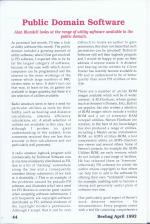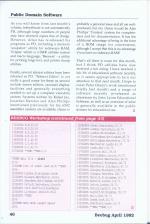
Beebug
 1st April 1992
1st April 1992
Author: Alan Blundell
Published in Beebug Volume 10 Number 10
Alan Blundell looks at the range of utility software available in the public domain.
Public Domain Software
As promised last month, I'll take a look at utility software this month. The public domain includes a growing amount of utility software; when I first got involved in PD software, I expected this to be by far the largest category of software, because of the ease with which Acorn computers can be programmed and the interest in the inner workings of the system which large numbers of BBC owners seem to have. It didn't turn out that way, at least so far, as games are available in larger quantity, but there is a fair selection of utilities available.
Radio amateurs seem to have a need for particular utilities as tools for their hobby, such as bearing and distance calculations, antenna efficiency calculations, etc. A small selection of utilities are available in this area, but although I profess no great understanding of the subject, from comments received they are less than accurate in their calculations and not particularly well presented.
A radio amateur logbook program sold commercially by Technical Software was at one time mistakenly distributed as PD, due to a bit of "hacking' somewhere along the line and a consequently mistaken library submission (if we look at it charitably...). This is an example of the problems caused by pseudo-PD software, and illustrates why I see a need for PD libraries to exercise great caution when accepting software submissions. I still frequently see copyright software distributed as PD, without evidence of the copyright holder's permission.
Although I accept that it can be very difficult to locate an author to gain permission, this does not mean that such permission can be assumed! Technical Software still sell their logbook program and I would be happy to pass on their address if anyone wants it. A distance and bearing utility written by Glynn Fowler has recently become available as PD and is understood to be of better quality than most PD utilities of this type.
There are a number of utility ROM images available which will be of wider interest. A.M.Flintham, whose games (such as Sorcerer's Domain, Exiz, Zedon) are popular, has also written a selection of ROM images which include a toolkit ROM and a set of sideways RAM notepad utilities. Steven Flintham (no relation, to the best of my knowledge) has also produced a range of utilities, including a Master series initialisation ROM, an ADFS utilities ROM, a text compression utility, an ADFS directory tree viewer and several others. Some of Steven's projects, for example the ADFS Utilities ROM, are early versions, which do not include a vast range of facilities.
He has released them as 'freeware' (effectively PD software for which the author retains copyright) so that others can help him to add to the software by offering their own "*command' routines for example, enabling each to become a strong and genuinely useful piece of software over time.
One particularly good aspect of Steven's work deserves mention - his documentation. Every program comes with a text file containing comprehensive documentation, which is genuinely useful with any software except perhaps simple games which are completely self-explanatory. The more we see of this standard of documentation, the better in my view. If you are writing software which you want to release to other people, remember that documentation takes little time compared with how long it takes you to complete your masterpiece, but can make all the difference to someone trying to make use of it.
The documentation provided for the small but well-produced range of PD software available from Lancaster University's National Public Domain Software Archive is also exemplary. NPDSA is a central resource maintained by the University which covers a range of micros. Large ranges of software for PCs, Amigas and STs are available, but there is a BBC area.
It includes some less common utilities such as a file archive/unarchive system, a customisable toolkit ROM, 'HandiROM', which is useful as an aid to some disabled people in their use of their micro, a printer redirection utility and a function keystrip printer.
Lars Osterballe, who seems to have been mentioned more than once in this column, has produced several utilities, including a disc cache program which uses spare sideways RAM to buffer disc accesses. Although I haven't used it myself, I see this being most useful for byte level access to files, rather than straightforward load/save functions. Also of note is his Dynamics ROM, which is a system for collecting your favourite machine code utilities into one ROM image for use in sideways RAM: the 'dynamic' refers to the fact that these utilities may be added to or removed from the system at your convenience.
Specifically for Master users, Andrew Fiddaman has developed a Master series utility ROM with a wide range of commands which he has released as shareware.
As you might expect, there are quite a number of commonly used utilities such as character designers, font designers, function keystrip printers and sound envelope designers. Each tends to have its own strengths and weaknesses, but I think that most people probably have at least one or two such utilities by now, unless they have no use for them at all, as programs of this type have been published in quantity over the years in magazines, via telesoftware and by small commercial operations.
Sideways ROM/RAM utilities are another popular area with programmers, with programs such as ROM image load/save utilities, ROM managers, emulations of the Master's *UNPLUG command, and others for Model B owners. Andrew Pepperell has produced a memory utilities ROM for use on either range of micros, which includes the full source code on disc. In my opinion, this is an excellent practice; if you release your work as PD, what is the point of keeping the source code to yourself? Availability of source code helps less experienced programmers to develop their own skills and someone may even produce an improved version of your program which will be of benefit to you as well as to others. So long as everyone acts honourably and doesn't try to pass off your work as their own, everyone gains.
Allan Kelly has produced a range of utilities which were originally distributed by the BBC's Telesoftware service before it sadly ceased to operate. As you will know from last month's column, telesoftware is not automatically PD, although large numbers of people may have received copies free of charge. However, Allan has re-released his programs as PD, including a memory 'snapshot" utility for sideways RAM, 'Eclipse' which is a SWR utilities system and macro language, 'Banners' - a utility for printing large text, and printer dump utilities.
Finally, several teletext editors have been released as PD. 'Teletext Editor' is not really a good name for these as several include screen editors, carousel display facilities and generally everything needed to set up a complete viewdata system. Systems written by Rafael Jay, Jonathan Harston and Alan Phillips (mentioned previously for his 6502 assembler system) are available; choice is probably a personal issue and all are well-produced, but my choice would be Alan Phillips' 'Fanfare' system for completeness and for documentation. It has the additional advantage of being in the form of a ROM image for convenience, although T accept that this is no advantage if you have no sideways RAM!
That's all there is room for this month, but I think PD utilities have now received a fair airing. I have received a fair bit of educational software recently, so it seems appropriate to turn our attention to that next month. I hope to cover Peter Davey's work (mentioned briefly last month) and a range of software recently re-released as shareware by John Lyons Educational Software, as well as an overview of what is generally available in the public domain for educational use.
This article was converted to a web page from the following pages of Beebug Volume 10 Number 10.




